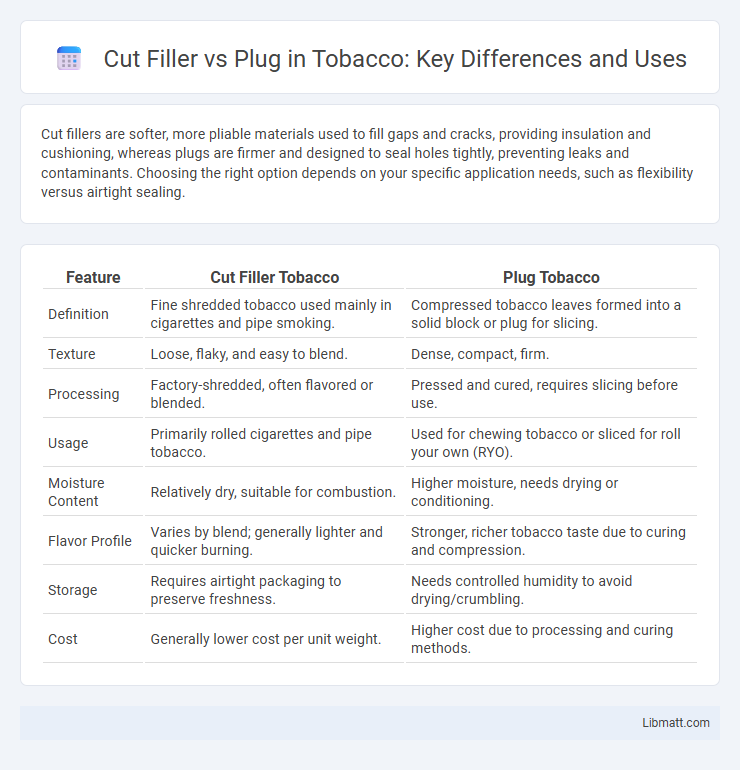Cut fillers are softer, more pliable materials used to fill gaps and cracks, providing insulation and cushioning, whereas plugs are firmer and designed to seal holes tightly, preventing leaks and contaminants. Choosing the right option depends on your specific application needs, such as flexibility versus airtight sealing.
Table of Comparison
| Feature | Cut Filler Tobacco | Plug Tobacco |
|---|---|---|
| Definition | Fine shredded tobacco used mainly in cigarettes and pipe smoking. | Compressed tobacco leaves formed into a solid block or plug for slicing. |
| Texture | Loose, flaky, and easy to blend. | Dense, compact, firm. |
| Processing | Factory-shredded, often flavored or blended. | Pressed and cured, requires slicing before use. |
| Usage | Primarily rolled cigarettes and pipe tobacco. | Used for chewing tobacco or sliced for roll your own (RYO). |
| Moisture Content | Relatively dry, suitable for combustion. | Higher moisture, needs drying or conditioning. |
| Flavor Profile | Varies by blend; generally lighter and quicker burning. | Stronger, richer tobacco taste due to curing and compression. |
| Storage | Requires airtight packaging to preserve freshness. | Needs controlled humidity to avoid drying/crumbling. |
| Cost | Generally lower cost per unit weight. | Higher cost due to processing and curing methods. |
Introduction to Cut Filler and Plug
Cut filler and plug are essential techniques used in stone restoration and repair, addressing cracks and holes in surfaces like marble and granite. Cut filler involves injecting a resin mixture into precisely cut channels to seamlessly fill cracks, ensuring structural integrity and aesthetic appeal. Plug refers to filling larger voids or chips with shaped material for durable and visually consistent repairs that restore the original surface.
What is Cut Filler?
Cut filler refers to small, precisely cut pieces of wood used to fill gaps or blemishes in woodworking and cabinet making. Unlike plugs, which are round and typically used to cover screw holes, cut fillers are shaped to match the voids' dimensions for a seamless repair. Your choice between cut filler and plug depends on the size and shape of the imperfection you need to correct.
What is Plug Tobacco?
Plug tobacco is a type of chewing tobacco formed into dense, compressed blocks or cubes, providing a slow-burning, long-lasting chew. It is made by pressing shredded tobacco leaves with sweeteners or flavorings, resulting in a moist, flavorful product that requires cutting or biting small pieces for use. Unlike cut filler, which is loose shredded tobacco used primarily for pipe smoking or roll-your-own cigarettes, plug tobacco is designed specifically for chewing.
Key Differences Between Cut Filler and Plug
Cut filler refers to small pieces of wood used to fill minor gaps or imperfections in woodworking, providing a smooth, seamless finish. Plug involves larger, solid wood sections inserted into pre-drilled holes to cover screw heads or defects, offering structural reinforcement and aesthetic consistency. Key differences include size and purpose: cut filler is primarily cosmetic for minor repairs, while plugs serve both decorative and functional roles in joinery.
Production Process Comparison
Cut fillers involve removing damaged or imperfect sections of a wood piece and replacing them with matching wood inserts, which requires precise cutting, fitting, and gluing to ensure seamless integration. In contrast, plugs are typically cylindrical pieces inserted into drilled holes to cover screw heads or defects, a simpler and faster process that prioritizes surface aesthetics over structural repair. Your choice between cut filler and plug depends on the desired finish quality and the complexity of the production workflow.
Flavor Profiles: Cut Filler vs Plug
Cut filler tobacco offers a lighter, more delicate flavor profile due to its finely shredded texture, allowing for quicker burning and a smoother smoke. Plug tobacco, being densely compressed and sliced from a solid block, provides a richer, more robust taste with prolonged flavor release. If you seek a bolder smoking experience, your choice may lean toward plug for its intense and lasting character.
Smoking Experience: Cut Filler vs Plug
Cut filler tobacco offers a smoother, more consistent burn that enhances the smoking experience by providing a balanced flavor and easy packing, while plug tobacco, being denser and often pressed, tends to burn slower and delivers a richer, stronger taste. Smokers who prefer a lighter, more customizable smoke often choose cut filler, whereas those seeking a longer-lasting and more intense flavor profile typically opt for plug tobacco. The choice between cut filler and plug impacts moisture retention, burn rate, and overall satisfaction during smoking.
Cost and Availability
Cut fillers are generally more cost-effective and widely available due to their mass production and standard sizes, making them a budget-friendly option for most projects. Plug fillers, while often pricier, are specialized inserts designed for unique or custom applications where precise fit and material matching are critical. Your choice depends on balancing the upfront cost with the availability of suitable sizes and the specific requirements of your repair or construction needs.
Which is Better: Cut Filler or Plug?
Cut filler offers a seamless blend and is ideal for achieving a natural look on wood surfaces, making it superior for fine woodworking or furniture repair. Plug repairs are more durable and suitable for filling large holes or damaged areas, providing structural stability but a less refined finish. Your choice between cut filler and plug depends on whether you prioritize aesthetics or strength in your woodworking project.
Conclusion: Choosing the Right Tobacco
Selecting the right tobacco between cut filler and plug depends on personal preference and intended use. Cut filler tobacco is ideal for blending and easy packing, offering consistent burn and flavor, while plug tobacco provides a denser, longer-lasting smoke with robust taste. Understanding the differences in texture, moisture, and smoking experience ensures a satisfying choice tailored to individual smoking habits.
cut filler vs plug Infographic

 libmatt.com
libmatt.com